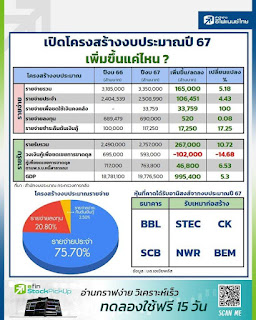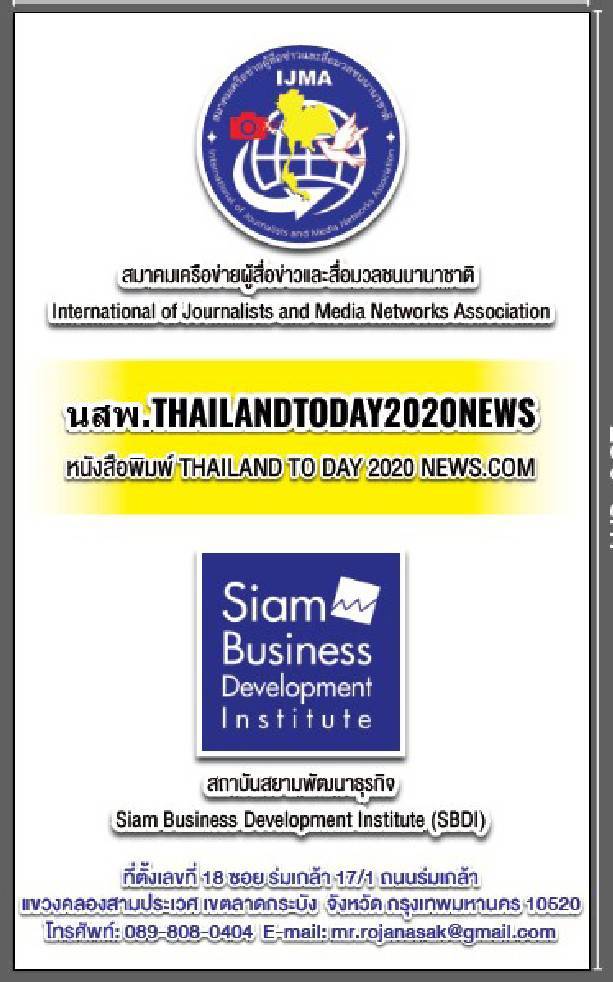
กระทรวงการคลังคาดว่าเศรษฐกิจไทยปี 2567 จะขยายตัวเร่งขึ้นที่ร้อยละ 3.2 ต่อปี (THAI/ENG)
นายพรชัย ฐีระเวช ผู้อำนวยการสำนักงานเศรษฐกิจการคลัง ในฐานะโฆษกกระทรวงการคลัง แถลงผลการประมาณการเศรษฐกิจไทยปี 2567 กระทรวงการคลังคาดว่าเศรษฐกิจไทยจะขยายตัวเร่งขึ้นที่ร้อยละ 3.2 ต่อปี (ช่วงคาดการณ์ที่ร้อยละ 2.2 ถึง 4.2) โดยได้รับปัจจัยสนับสนุนจากการบริโภคภาคเอกชน และภาคการส่งออก กอปรกับภาคการท่องเที่ยวที่ยังฟื้นตัวต่อเนื่อง โดยคาดว่าในปี 2567 จะมีนักท่องเที่ยวชาวต่างประเทศเดินทางเข้ามาในประเทศไทยจำนวน 34.5 ล้านคน ขยายตัวที่ร้อยละ 24.6 ต่อปี ส่งผลดีต่อภาคการท่องเที่ยวและธุรกิจบริการที่เกี่ยวข้อง เกิดการจ้างงานและเพิ่มรายได้ประชาชน โดยคาดว่าการบริโภคภาคเอกชนจะขยายตัวได้ต่อเนื่องที่ร้อยละ 3.1 ต่อปี (ช่วงคาดการณ์ที่ร้อยละ 2.1 ถึง 4.1) ขณะที่การส่งออกสินค้ามีแนวโน้มขยายตัวต่อเนื่องตามอุปสงค์ในตลาดโลกและเศรษฐกิจประเทศคู่ค้า โดยคาดว่าการส่งออกสินค้าจะขยายตัวที่ร้อยละ 4.4 ต่อปี (ช่วงคาดการณ์ที่ร้อยละ 3.4 ถึง 5.4) ส่งผลดีต่อความเชื่อมั่นของภาคธุรกิจทำให้คาดว่าการลงทุนภาคเอกชนจะขยายตัวที่ร้อยละ 3.5 ต่อปี (ช่วงคาดการณ์ที่ร้อยละ 2.5 ถึง 4.5) อย่างไรก็ดี การประมาณการเศรษฐกิจไทยปี 2567 ในครั้งนี้ ยังไม่ได้รวมผลกระทบของมาตรการเศรษฐกิจที่อยู่ระหว่างการพิจารณาดำเนินการโดยเฉพาะนโยบายโครงการเติมเงิน 10,000 บาท ผ่าน Digital Wallet
ในด้านเสถียรภาพภายในประเทศ คาดว่าอัตราเงินเฟ้อทั่วไปจะอยู่ที่ร้อยละ 2.2 ต่อปี (ช่วงคาดการณ์ที่ร้อยละ 1.2 ถึง 3.2) เร่งขึ้นจากปีก่อนหน้าตามอุปสงค์ภายในประเทศที่ขยายตัวดี ขณะที่เสถียรภาพภายนอกประเทศ คาดว่าดุลบัญชีเดินสะพัดจะเกินดุล 8.3 พันล้านดอลลาร์สหรัฐ หรือคิดเป็นร้อยละ 1.5 ของ GDP (ช่วงคาดการณ์ที่ร้อยละ 0.5 ถึง 2.5 ของ GDP)
ทั้งนี้ โฆษกกระทรวงการคลังได้กล่าวทิ้งท้ายว่า สำหรับปัจจัยสำคัญที่จะส่งผลกระทบต่อเศรษฐกิจไทยซึ่งต้องติดตามอย่างใกล้ชิด อาทิ 1) ความขัดแย้งทางภูมิรัฐศาสตร์โลกในภูมิภาคต่าง ๆ ซึ่งอาจเป็นข้อจำกัดต่อการเติบโตของเศรษฐกิจไทยในระยะถัดไป เช่น สถานการณ์สู้รบในอิสราเอลและกาซาที่อาจส่งผลกระทบต่อราคาพลังงานให้ปรับตัวสูงขึ้น ความยืดเยื้อของสงครามระหว่างรัสเซียและยูเครน และการแข่งขันเชิงยุทธศาสตร์ระหว่างจีนและสหรัฐฯ ซึ่งอาจส่งผลกระทบต่อห่วงโซ่อุปทานโลกและการค้าระหว่างประเทศ จำเป็นต้องติดตามบทบาทและท่าทีของแต่ละประเทศอย่างใกล้ชิด 2) ความผันผวนของตลาดการเงินโลกจากการดำเนินนโยบายการเงินที่เข้มงวดของประเทศคู่ค้าหลักและปัญหาสถาบันการเงินในต่างประเทศ โดยเฉพาะประเทศสหรัฐอเมริกาและสหภาพยุโรป 3) สถานการณ์เศรษฐกิจจีนที่ประสบปัญหาการชะลอตัวทางเศรษฐกิจ ส่งผลต่อการส่งออกและการฟื้นตัวของภาคการท่องเที่ยวของไทย และ 4) ปรากฏการณ์เอลนีโญ (El Niño) ที่อาจทำให้เกิดภัยแล้งในปี 2567 ส่งผลกระทบต่อรายได้เกษตรกร
นอกจากนี้ นายพรชัย ฐีระเวช ผู้อำนวยการสำนักงานเศรษฐกิจการคลัง ในฐานะโฆษกกระทรวงการคลัง แถลงผลการประมาณการเศรษฐกิจไทยปี 2566 ว่า “เศรษฐกิจไทยปี 2566 คาดว่าจะขยายตัวที่ร้อยละ 2.7 (ช่วงคาดการณ์ที่ร้อยละ 2.2 ถึง 3.2) ขยายตัวต่อเนื่องจากปี 2565 ที่ขยายตัวที่ร้อยละ 2.6 ต่อปี โดยภาคการท่องเที่ยวและอุปสงค์ภายในประเทศโดยเฉพาะการบริโภคภาคเอกชนเป็นปัจจัยขับเคลื่อนสำคัญ โดยคาดว่าทั้งปี 2566 จะมีจำนวนนักท่องเที่ยวชาวต่างประเทศเดินทางเข้ามาในประเทศไทยจำนวน 27.7 ล้านคน ขยายตัวที่ร้อยละ 148.3 ต่อปี และมีรายได้จากการท่องเที่ยวของนักท่องเที่ยวต่างชาติ จำนวน 1.18 ล้านล้านบาท เพิ่มขึ้นร้อยละ 225.5 จากปี 2565 และการบริโภคภาคเอกชนที่ฟื้นตัวอย่างต่อเนื่อง โดยคาดว่าจะขยายตัวได้ต่อเนื่องที่ร้อยละ 5.8 (ช่วงคาดการณ์ที่ร้อยละ 5.3 ถึง 6.3) รวมถึงแรงกดดันของอัตราเงินเฟ้อที่คลี่คลายลง สำหรับการลงทุนภาคเอกชนคาดว่าจะขยายตัวที่ร้อยละ 0.9 (ช่วงคาดการณ์ที่ร้อยละ 0.4 ถึง 1.4) สำหรับมูลค่าการส่งออกสินค้าในรูปเงินสกุลดอลลาร์สหรัฐคาดว่าจะหดตัวที่ร้อยละ -1.8 (ช่วงคาดการณ์ที่ร้อยละ –2.3 ถึง -1.3) เนื่องจากได้รับผลกระทบจากการชะลอตัวของเศรษฐกิจคู่ค้าสำคัญของไทย
นอกจากนี้ การบริโภคภาครัฐคาดว่าจะหดตัวที่ร้อยละ -3.4 (ช่วงคาดการณ์ที่ร้อยละ -3.9 ถึง -2.9) ในขณะที่การลงทุนภาครัฐคาดว่าจะทรงตัวในระดับเดียวกับปีก่อนหน้า โดยส่วนหนึ่งเป็นผลมาจากกระบวนการจัดทำงบประมาณรายจ่ายประจำปี 2567 ที่ล่าช้ากว่าปีที่ผ่านมา
ในด้านเสถียรภาพภายในประเทศ คาดว่าอัตราเงินเฟ้อทั่วไปจะอยู่ที่ร้อยละ 1.5 (ช่วงคาดการณ์ที่ร้อยละ1.0 ถึง 2.0) เนื่องจากแรงกดดันจากราคาสินค้าในหมวดพลังงานได้คลี่คลายลงตามลำดับ ประกอบกับมาตรการบรรเทาของภาครัฐที่ช่วยบรรเทาภาระค่าครองชีพของประชาชน ทำให้เงินเฟ้อกลับเข้ามาสู่กรอบเป้าหมายที่ร้อยละ 1 – 3 สำหรับเสถียรภาพภายนอกประเทศ ดุลบริการมีแนวโน้มจะกลับมาเกินดุลตามการเพิ่มขึ้นของจำนวนนักท่องเที่ยวต่างชาติ ส่งผลให้ดุลบัญชีเดินสะพัดในปี 2566 มีแนวโน้มที่จะกลับมาเกินดุล 2.7 พันล้านดอลลาร์สหรัฐ หรือคิดเป็นร้อยละ 0.5 ของ GDP

The Ministry of Finance expects that the Thai economy in 2017 will accelerate at 3.2 percent per annum.
Mr. Pornchai Thiravej, the director general of the Fiscal Policy Office (FPO), as a spokesman for Ministry of Finance, announced the Thai economy’s forecast for 2020 at 3.2 percent per annum (or 2.2 to 4 percent).2) This was supported by private consumption and exports, as well as the recovery of tourism sector. It is expected that 34.5 million foreign tourists will visit Thailand in 2014, growing 24. percent.6 p.a. This will benefit tourism and related services sectors, create jobs and increase public income. Private consumption is expected to grow at 3.1 percent per annum (estimate range of 2.1 – 4.1 percent). Meanwhile, exports of goods are likely to continue growing in line with world demand and trading partners’ economies.4 per cent per annum (estimated range 3.4 to 5.4 per cent), which will help boost business confidence. Therefore, it is expected that private investment will grow 3.5 per cent per annum (estimated range 2.5 to 4.5 per cent).The Thai economic projection for 2017 does not include the impact of economic measures under consideration, particularly the 10,000 baht prepaid plan via Digital Wallet.
On the domestic stability front, headline inflation is expected to be around 2.2 percent per annum (between 1.2 and 3 percent).2) Accelerating from the previous year in line with strong domestic demand. External stability is expected to post a surplus of USD8.3 billion, or 1.5 percent of GDP (expected 0.5-2 percent).5 of GDP)
The Finance Ministry Spokesperson concluded that key factors that must be closely monitored include 1) global geopolitical conflicts in various regions, which may limit Thailand’s economic growth in the future, such as the fighting situation in Israel and Gaza that may affect energy prices. The prolonged war between Russia and Ukraine and strategic competition between China and the US, which may affect global supply chains and international trade, should be closely monitored. 2) Global financial market volatility due to the tight monetary policy of major trading partners and foreign financial institutions. Especially in the US and EU. 3) China’s economic slowdown has adversely affected Thailand’s exports and tourism sector, and 4) El Niño, which may cause drought in 2014, has affected farm income.
In addition, Mr. Pornchai Thiravej, Director of the Fiscal Policy Office (FPO), as a spokesman for Ministry of Finance. The Thai economy in 2020 is expected to grow at 2.7 percent (preliminary range of 2.2 to 3.2 percent), continuing from the growth of 2 percent in 2025.6 p.a. Tourism and domestic demand, particularly private consumption, are key drivers. It is expected that the number of foreign tourists visiting Thailand in 2013 will reach 27.7 million, growing 148.3 percent YoY and tourism revenue of THB1.18 trillion, up 225.5 from 2022, and continuous recovery in private consumption, which is expected to grow by 5.8 percent (expected 5.3 to 6.3 percent), plus easing inflationary pressure. Private investment is projected to grow by 0.9 percent (expected 0.4 to 1.4 percent). Meanwhile, exports of goods in USD terms are expected to contract by -1.8 (expected range of –2.3 to -1.3 percent) as a result of the slowdown in Thailand’s major trading partners’ economies.
In addition, government consumption is expected to contract at -3.4 percent (expected range of -3.9 to -2.9) Meanwhile, public investment is expected to remain at the same level as last year, partly due to a delay in the preparation of expenditure budget for 2017.
Regarding internal stability, headline inflation is expected to be around 1.5 percent (or within the range of 1.0 to 2. percent).0) Due to easing pressure on energy prices and the government’s cost-of-living relief measures, inflation has returned to the target range of 1-3%. External stability will likely see a service surplus in line with the increase in foreign tourists. It is likely to return to a surplus of USD2.7 billion, accounting for 0.5 percent of GDP.










